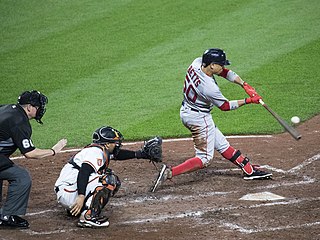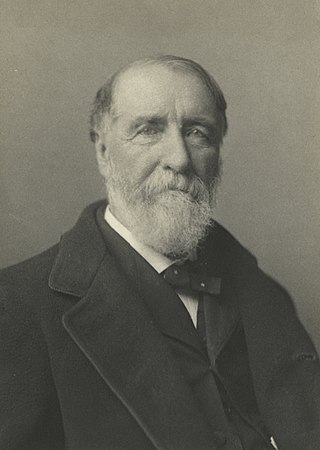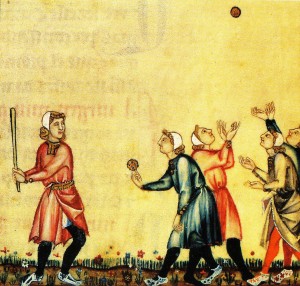History
Late 19th Century
The National Rounders Association had strong ties to Merseyside, where in April 1886 they were one of a number of locally based sporting institutions with elected representation onto the directorate of the Liverpool Athletic Grounds Company Ltd. [3] By the 1890s, calls were made to follow the success of other working class sports such as football, on Merseyside, and adopt a distinct set of rules and bureaucracy. [4]
The National Rounders Association created a new game, drawing on the much older game of rounders but with new rules that they hoped would appeal to adults. With plans to spread this new game across the entire United Kingdom. Gloucester adopted the sport in 1887, with the Gloucester Rounders Association formed in 1888. [5] In South Wales the game took hold in 1889, four clubs were created in South Wales who in 1890 then formed the South Wales Rounders Association. [6] In 1892, in “finding there was so much prejudice against the name” the National Rounders Association and the South Wales Rounders Association dropped ‘rounders’ and replaced this with ‘baseball’. [7] By the end of the 1892 season, baseball teams from Liverpool and Lancashire were invited to play matches at Cardiff Arms Park with the express purpose of popularising "the improved version of the old-fashioned game of rounders". [8]
A rival organisation appeared in May 1892, when it was reported that the Gloucestershire Rounders Association had become the English Baseball Association, with leagues already under way. [9] By June 1892 baseball in Gloucestershire was being referred to as the ‘Gloucestershire English Baseball Association’ and the leagues were still in full swing. [10] This was a short lived enterprise.
In June 1892 Newton Crane, the President of the National Baseball Association (the body responsible for the overseeing of the American rules of baseball in Great Britain) wrote an open letter in the Liverpool Mercury, stating that Derby Baseball Club had accepted the challenge of the Chief Executive Officer of the National Rounders Association (by now renamed as the English Baseball Association), that a team of the best rounders players could defeat a team of the best ‘American rules’ baseball players in Britain. The matches would “be played according to the genuine or regular baseball rules”, with a match each in Liverpool and Derby. [11]
By 1894 the Liverpool and District Baseball League was established and the game was flourishing on Merseyside and parts of Lancashire and South Wales. [12] In April 1899, at the annual meeting of the English Baseball Association in Liverpool, it was resolved that the rules of the game would be changed, to speed up play and tackle the “waiting tactics adopted by batsmen”. The change would see batters face two “good balls” instead of three, and that on the third “good ball” the batter would get an “extra” ball. [13]
Early 20th Century and the First World War
During World War I the English Baseball Association were keen on keeping baseball ticking over in the Liverpool region, despite a lack of experienced players. In February 1916 the annual meeting was held, with the primary topic of discussion being efforts to utilise munitions workers and others to supplement existing teams [14] , and the English Baseball Association organised games to raise funds for the war effort. [15]
In August 1918 the English Baseball Association organised an international fixture, whereby England took on Canada at the Police Athletic Ground in the Fairfield area of Liverpool. [16] This game was advertised to have been ‘American baseball’. [17] By September 1922 the need for better officiating of games was recognised and the Umpire’s Association was formed. [18] In July 1921 there were efforts for the establishment of a National Baseball Council, where members of the English Baseball Association and South Wales Baseball Association met to discuss the formation of the new governing body. [19]
In an effort to spread the native baseball rules exhibition games were organised by the English Baseball Association, in London, in 1924. Liverpool and Scotland international Donald McKinlay was one of the baseball players on show. [20] In Cardiff in 1922 and in 1926 the first women's international match took place between Wales and England. The crowd at the 1924 Cardiff Arms Park men's international reached 10,000 spectators for the first time and the 1925 fixture at the Police Athletic Ground, Liverpool, saw a crowd of 12,000. The growth of the international fixture had brought increased scrutiny on the game's arbitration and rules, as such the English Baseball Association and the Welsh Baseball Union formed the International Baseball Board to oversee the internationals in 1927.
In September 1925 it was reported in the Liverpool Echo that a “revolutionary change in bowling” was being mulled over by the English Baseball Association. The new proposed rule would be “that when the bowler has sent up the third bad ball before he has sent up the second good ball, the batter shall be allowed to go to the first base, and the batting side shall have a bye recorded in their favour. If the first base, at the time, is occupied by another batter, that batter should go to second base. If two or three bases are occupied by batters at the time, each batter shall proceed to his next base, the batter at third base reaching home; but no batter at second or third base shall go to his next base except to make way for the batter occupying the next previous base.” [21]
The Athletic News reported, in June 1927, that a British Cup was being considered, between the finalists of the English Baseball Association and Welsh Baseball Union championships. [22] By 1927 the English Baseball Association had three divisions, with a total of 23 clubs across Merseyside and attendances were outstripping those at greyhound racing stadiums. A number of international rugby, football and cricket players were taking up the game and Everton and Liverpool football clubs were heavily involved. [23] Finally, in May 1929, the rules of the English Baseball Association were copyrighted. [24]
Depression, the Second World War and the American game (1929 to 1948)
The decade also saw further moves to establish American baseball on Merseyside. The moves met with a mixed reception among players of the English game with some apprehensive the move would end the older game in England. Although English baseball would survive, the American league had a detrimental effect throughout the decade, with players, crowds and backers leaving the sport for a professional career in a game gaining support throughout England. [25]
Post-war period (1948 to 1970)
The sport was also enjoying popularity In England, with a number of Exhibition games played in London and teams established in Bristol and Coventry.
Modern era
By 2006 participation levels in England had slumped considerably to a point where only four clubs remained active: All Saints, Anfield, Breckside and Townsend. [26]
The centenary international was held in Cardiff on 19 July 2008, with Wales winning their tenth victory in a row by an innings and 44. As well as the full international, similar internationals are held for 'B' teams and for junior grades. The match was the 83rd international played between the two nations, and was Wales' 61st victory; England had won 20 and two games were declared draws due to inclement weather (1957 and 1998). Spectator numbers were reported to be between 1,000 and 2,000. [27] [28]
The annual England–Wales fixture continued until 2015 when England withdrew, unable to field enough players. The end of the international fixture (and the exposure it brought the game) had a dramatic effect on player numbers in Wales. By 2017, the Welsh men's league and cup fixtures were abandoned mid-season due to a lack of players at some member clubs. In 2021 the Welsh Men's League & Cup was restarted after a 6 years hiatus with 5 clubs, with 7 in 2022. A programme of teaching baseball in Cardiff & Vale schools also started this year with a view to a full youth and junior league restarting in 2023. The women's league has remained in operation. [29] [30] [31]












